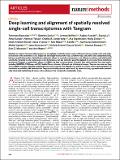| dc.contributor.author | Biancalani, Tommaso | |
| dc.contributor.author | Scalia, Gabriele | |
| dc.contributor.author | Buffoni, Lorenzo | |
| dc.contributor.author | Avasthi, Raghav | |
| dc.contributor.author | Lu, Ziqing | |
| dc.contributor.author | Sanger, Aman | |
| dc.contributor.author | Tokcan, Neriman | |
| dc.contributor.author | Vanderburg, Charles R | |
| dc.contributor.author | Segerstolpe, Åsa | |
| dc.contributor.author | Zhang, Meng | |
| dc.contributor.author | Avraham-Davidi, Inbal | |
| dc.contributor.author | Vickovic, Sanja | |
| dc.contributor.author | Nitzan, Mor | |
| dc.contributor.author | Ma, Sai | |
| dc.contributor.author | Subramanian, Ayshwarya | |
| dc.contributor.author | Lipinski, Michal | |
| dc.contributor.author | Buenrostro, Jason | |
| dc.contributor.author | Brown, Nik Bear | |
| dc.contributor.author | Fanelli, Duccio | |
| dc.contributor.author | Zhuang, Xiaowei | |
| dc.contributor.author | Macosko, Evan Z | |
| dc.contributor.author | Regev, Aviv | |
| dc.date.accessioned | 2023-01-13T14:13:43Z | |
| dc.date.available | 2023-01-13T14:13:43Z | |
| dc.date.issued | 2021 | |
| dc.identifier.uri | https://hdl.handle.net/1721.1/147094 | |
| dc.description.abstract | <jats:title>Abstract</jats:title><jats:p>Charting an organs’ biological atlas requires us to spatially resolve the entire single-cell transcriptome, and to relate such cellular features to the anatomical scale. Single-cell and single-nucleus RNA-seq (sc/snRNA-seq) can profile cells comprehensively, but lose spatial information. Spatial transcriptomics allows for spatial measurements, but at lower resolution and with limited sensitivity. Targeted in situ technologies solve both issues, but are limited in gene throughput. To overcome these limitations we present Tangram, a method that aligns sc/snRNA-seq data to various forms of spatial data collected from the same region, including MERFISH, STARmap, smFISH, Spatial Transcriptomics (Visium) and histological images. Tangram can map any type of sc/snRNA-seq data, including multimodal data such as those from SHARE-seq, which we used to reveal spatial patterns of chromatin accessibility. We demonstrate Tangram on healthy mouse brain tissue, by reconstructing a genome-wide anatomically integrated spatial map at single-cell resolution of the visual and somatomotor areas.</jats:p> | en_US |
| dc.language.iso | en | |
| dc.publisher | Springer Science and Business Media LLC | en_US |
| dc.relation.isversionof | 10.1038/S41592-021-01264-7 | en_US |
| dc.rights | Creative Commons Attribution 4.0 International license | en_US |
| dc.rights.uri | https://creativecommons.org/licenses/by/4.0/ | en_US |
| dc.source | Nature | en_US |
| dc.title | Deep learning and alignment of spatially resolved single-cell transcriptomes with Tangram | en_US |
| dc.type | Article | en_US |
| dc.identifier.citation | Biancalani, Tommaso, Scalia, Gabriele, Buffoni, Lorenzo, Avasthi, Raghav, Lu, Ziqing et al. 2021. "Deep learning and alignment of spatially resolved single-cell transcriptomes with Tangram." Nature Methods, 18 (11). | |
| dc.contributor.department | Massachusetts Institute of Technology. Department of Biology | en_US |
| dc.relation.journal | Nature Methods | en_US |
| dc.eprint.version | Final published version | en_US |
| dc.type.uri | http://purl.org/eprint/type/JournalArticle | en_US |
| eprint.status | http://purl.org/eprint/status/PeerReviewed | en_US |
| dc.date.updated | 2023-01-13T14:05:42Z | |
| dspace.orderedauthors | Biancalani, T; Scalia, G; Buffoni, L; Avasthi, R; Lu, Z; Sanger, A; Tokcan, N; Vanderburg, CR; Segerstolpe, Å; Zhang, M; Avraham-Davidi, I; Vickovic, S; Nitzan, M; Ma, S; Subramanian, A; Lipinski, M; Buenrostro, J; Brown, NB; Fanelli, D; Zhuang, X; Macosko, EZ; Regev, A | en_US |
| dspace.date.submission | 2023-01-13T14:05:59Z | |
| mit.journal.volume | 18 | en_US |
| mit.journal.issue | 11 | en_US |
| mit.license | PUBLISHER_CC | |
| mit.metadata.status | Authority Work and Publication Information Needed | en_US |
